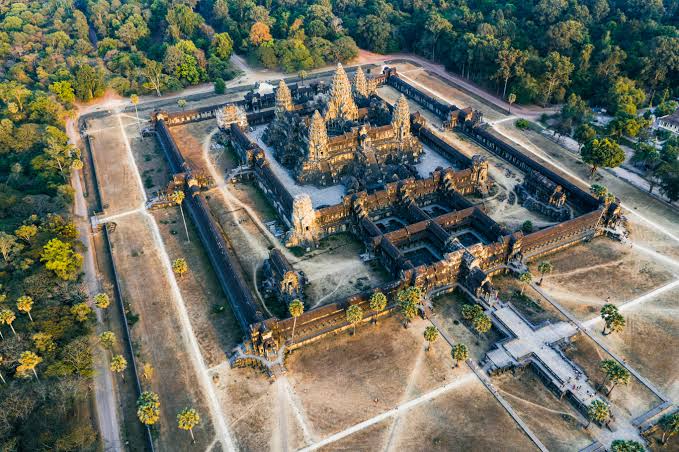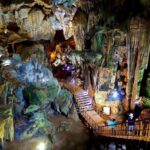The lovely old temples at Siem Reap, which lies in the heart of Cambodia, are famous all over the world. Millions of people come to see the beautiful Khmer architecture and spiritual history every year. This article is about the ten most important old temples in and around Siem Reap, Cambodia. It’s an interesting look at some of the most well-known archaeological sites in Southeast Asia. These old buildings are more than simply stone structures; they are living remnants of the Angkor Empire’s religious and cultural past. Each temple has its own story, faith, and stunning buildings. For instance, Angkor Wat is the biggest religious monument in the world, and the trees that hide the remains of Ta Prohm make them look even better.
These temples are more than just places to visit; they are distinct experiences. These places are absolutely stunning, whether you like the detailed stone carvings, the quiet jungle backdrop, or the spiritual atmosphere of shrines that have been around for hundreds of years. This long list is perfect for anyone who wish to arrange a meaningful vacation to Cambodia’s ancient temple circuit and are interested in history, culture, or travel. Learn about the Khmer culture and the most remarkable historic temples in Siem Reap. You can still hear the secrets of this society in the peaceful halls of these temples. You will be shocked by how holy these places are and how much history they have.
Top Ten Ancient Temples You Should Visit Around Siem Reap, Cambodia
10. Bakong
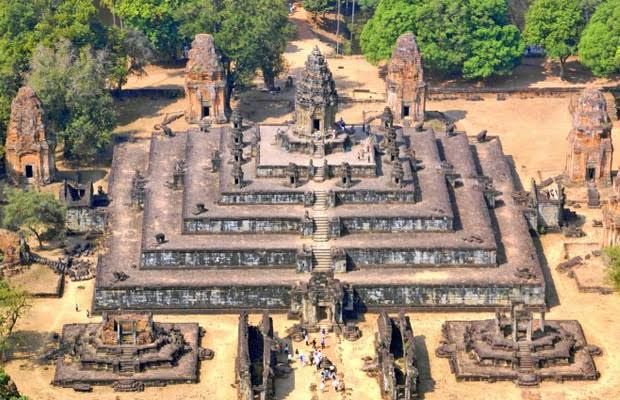
Bakong, completed in 881 AD by King Indravarman I, stands as the very first major sandstone temple‑mount in the Khmer Empire and served as the state temple of ancient Hariharalaya . Rising like Mount Meru from a serene moat, Bakong’s five ascending tiers symbolize the five realms of the Hindu cosmos. A stunning example of early Khmer innovation, its design draws heavily on Java’s Borobudur especially in its corbelled gateways and terraced layout suggesting cultural exchange with Sailendra craftsmen .
As visitors approach, they encounter a meticulously restored central sanctuary housing Sri Indresvara the combined name of Shiva and the king himself underscoring the temple’s role in the divine kingship cult . Guardian naga serpents and rakshasa demon sculptures add to the sense of stepping into a consecrated cosmic realm.
While Bakong no longer stands as the capital’s heart, additions from the 12th and 13th centuries bear witness to its enduring importance . Today this monumental pyramid offers a peaceful, less crowded insight into early Khmer temple‑mount architecture, perfect for travelers seeking depth, history, and photographic opportunity just a short drive from Siem Reap.
9. Phnom Bakheng

Phnom Bakheng, built between 889 and 910 AD during King Yasovarman I’s reign, is one of the earliest hilltop temple-mountains in the Angkor region . Dedicated to Shiva, it served as the heart of the first Angkor capital, Yasodharapura. The structure rises in six levels corresponding to Mount Meru’s seven tiers, crowned by a central tower and surrounded by 108 smaller towers representing lunar cycles .
The temple’s position atop a natural hill offers sweeping vistas across Siem Reap plains and Angkor Wat views that become breathtaking at sunset. Its quincunx arrangement frames the view of the larger Angkor Wat in the distance, creating one of the most iconic photographic scenes in Southeast Asia .
Phnom Bakheng’s historical significance is tied to its role as the state temple and urban anchor of Yasovarman’s new city . Over time, Buddhist statues were added, reflecting the shift from Hindu worship. Conservation efforts by the World Monuments Fund and APSARA began in 2004 in response to heavy visitor impact; today it carefully manages visitor numbers to preserve this fragile jewel .
The climb is moderately steep, and the site fills quickly at sunset arriving an hour before peak time is wise. The reward is a 360-degree panorama at golden hour, a memory that stays long after you leave.
8. Prasat Phnom Krom
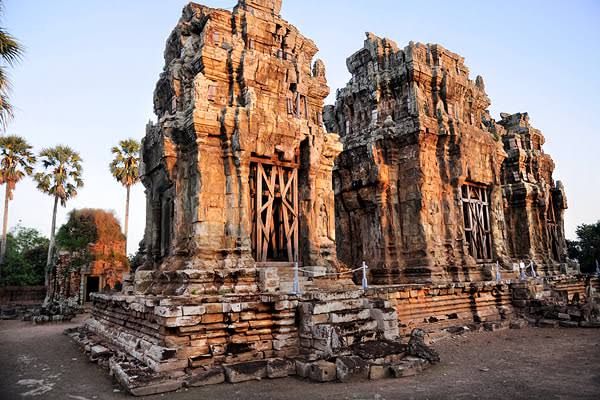
Perched 12 kilometers southwest of Siem Reap on a sandstone hill rising 140 meters above the plains, Prasat Phnom Krom is a serene hilltop shrine built in the late 9th or early 10th century under Yasovarman I . The complex comprises three sandstone and laterite towers aligned north‑south, dedicated respectively to Vishnu, Shiva, and Brahma an architectural echo of its sister hilltop temples Phnom Bakheng and Phnom Bok .
Encircled by a laterite wall with gates at the cardinal points, the compound likely housed crematoria in small annex buildings within the eastern precinct . Despite centuries of wind and rain, the temple retains a striking silhouette. While many intricate carvings have eroded, enough detail remains to hint at the once ornate lintels and colonnades .
Phnom Krom is one of the area’s quieter temples. Visitors can enjoy a scenic climb, a few Buddha statues, and a breathtaking sunset all with far fewer tourists than the Angkor core . A tuk‑tuk ride costs around ten US dollars roundtrip, with an Angkor Park pass required for access .
The hilltop view across lush fields and Tonlé Sap Lake offers a perfect blend of nature and heritage. Many travelers combine this visit with a stop at the nearby floating village and countryside restaurants. Phnom Krom captures the essence of a genuine, contemplative temple‑in‑the‑countryside experience.
7. Pre Rup

Pre Rup is a 10th‑century temple mountain constructed in 961 or 962 AD by King Rajendravarman II as his state temple . Built of brick, laterite, and sandstone, it stands just south of the East Baray reservoir, mirroring the baray’s layout. The name literally “turn the body” is believed to reference ancient cremation rituals possibly performed here .
The site consists of three ascending tiers crowned by five lotus-shaped towers. At the base, you find remnants of libraries and enclosures, along with statues and carved lintels that have survived centuries . Wooden supports now brace some outer towers, a reminder of both grandeur and vulnerability.
Pre Rup’s raised platform provides panoramic views, especially at sunset, when soft light bathes distant peaks and the golden stone turns warm. Travelers report it to be quieter at dusk compared to Phnom Bakheng or Angkor Wat, though it attracts a steady trickle of sunset‑watchers .
Rediscovered by French explorers in the early 20th century, Pre Rup was stabilized in the 1930s and remains in excellent condition, offering a rare combination of architectural drama and solitude . Its scenic beauty, intricate details, and spiritual atmosphere make it a must‑visit stop on Siem Reap’s grand circuit.
6. Banteay Kdei
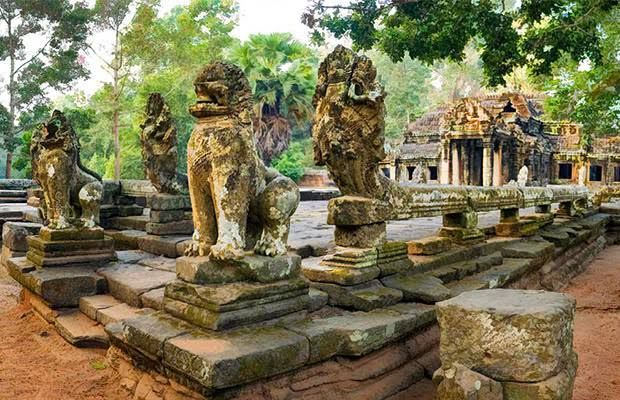
Banteay Kdei, meaning “Citadel of Chambers,” is a Buddhist monastic complex built by Jayavarman VII in the late 12th to early 13th century. Nestled just east of Angkor Thom and southeast of Ta Prohm, this temple follows Bayon‑style architecture but on a more intimate scale . Comprised of two concentric galleries within successive enclosure walls, Banteay Kdei once served as a residence for monks hence its more relaxed, quiet atmosphere.
The outer galleries are connected to a cruciform pavilion, where rotting pillars are supported by laterite braces for stability. Sculpted Buddha figures still peep through weathered columns, offering a serene contemplative ambiance far removed from the busiest Angkorian sites . The sandstone used here proved fragile, and centuries of neglect led to structural challenges. Modern laser scanning and conservation projects, in partnership with CyArk and Sophia University, have helped stabilize key areas and preserve fragile carvings .
Today, Banteay Kdei is a peaceful stop on the Siem Reap temple route. Its open courtyards, shaded walkways, and subtle Buddhist iconography such as meditative Buddha faces and lotus motifs create a tranquil setting for exploration. Visitors often find themselves wandering slowly, enjoying the gentle morning light casting soft shadows across its empty galleries. The temple’s understated beauty, lack of crowds, and evocative ruins make it a rewarding experience for history lovers and cultural travelers alike.
5. East Mebon & Prasat Kravan

East Mebon, a monumental temple built in the 10th century on an artificial island at the center of the former East Baray reservoir, is celebrated for its majestic stone elephants and dramatic riverbed sculpture . Dedicated to Shiva, the temple’s four corner towers rest upon a raised terrace that once lay surrounded by deep water. Each corner supports a massive carved elephant statue, a striking symbol of royal power. The central tower, now weathered, once held a golden linga and served as a shrine to the high gods.
Prasat Kravan, by contrast, is a much smaller brick sanctuary dedicated to Vishnu. Each of its five towers houses well‑preserved sandstone bas reliefs featuring lotus motifs, divine figures, and mythical creatures derived from sacred themes . Built with a red brick core and decorated with carved sandstone panels, this temple rich in intimate detail reveals the artistry of Khmer craftsmen on a human scale.
Both temples are located slightly off the main Angkor loop, making them ideal stops for explorers looking to escape the main crowds. The solid architectural lines, quiet courtyards, and glimpses of wildlife around the former reservoir make for a contemplative experience. The contrasting scales from the monumental presence of East Mebon to the discreet charm of Prasat Kravan showcase diverse expressions of sacred space within the Angkorian world.
4. Banteay Srei
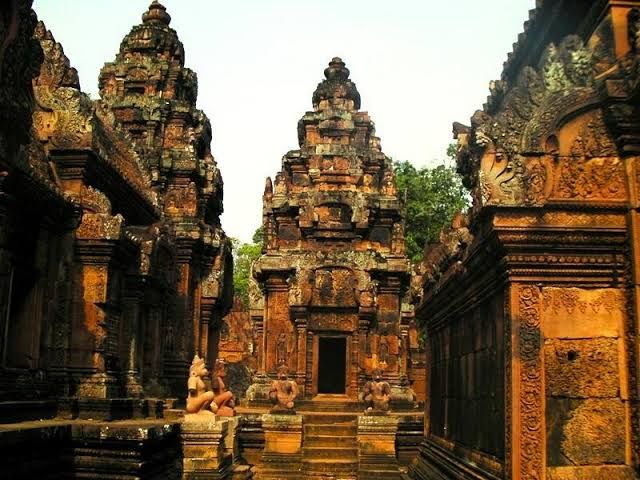
Banteay Srei is often hailed as the jewel of Khmer art. Built in 967 AD by the courtier Yajnavaraha rather than a monarch, this compact red‑sandstone masterpiece stands 25 km northeast of Siem Reap . Its pinkish glow at sunrise and sunset, coupled with detailed carvings of Hindu mythology, make it feel like a delicate jewel in the forest .
Every surface of Banteay Srei is covered in ornate reliefs. Pediments and lintels depict scenes featuring Shiva, Parvati, apsaras, and legends such as the Ramayana. The devata sculptures and Kala motifs are rendered with exquisite precision—so intricate that the temple became known as the “citadel of women” . Restoration pioneers used the technique of anastylosis here early in the 20th century, carefully reconstructing collapsed elements with minimal intervention . Today, conservation efforts protect its delicate sandstone from erosion and growing visitor numbers .
While small, Banteay Srei’s garden-like layout includes concentric enclosures, a central cruciform sanctuary, and low libraries surrounded by a broad moat . Visitors flock here for an hour at sunrise or sunset when cinematic lighting enhances the rosy hue. Its peaceful ambiance, refined artistry, and comparative solitude away from larger crowds makes it a top destination on the Angkor temple circuits.
3. Kbal Spean
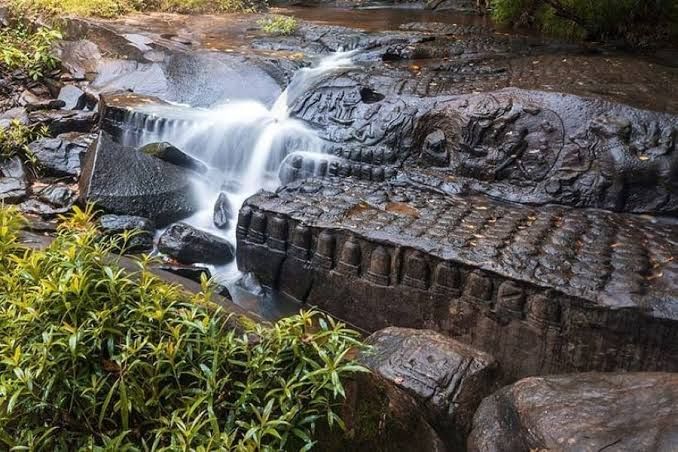
Kbal Spean, also known as the River of a Thousand Lingas, is an extraordinary archaeological gem nestled in the jungle of Phnom Kulen about 25 km northeast of Siem Reap. From the 11th to 12th centuries, kings Suryavarman I and Udayadityavarman II commissioned the carving of thousands of lingas Shiva’s phallic symbols directly into the sandstone riverbed, consecrating the water flowing downstream into Angkor’s reservoirs and fields .
A roughly 2 km uphill trek through lush foliage leads to the first set of carvings, beginning near a natural rock bridge and culminating at a waterfall. Along the way, detailed reliefs depict Vishnu reclining on the serpent Ananta, Shiva accompanied by Uma, cows, frogs and other Hindu deities . These images illustrate profound spiritual symbiosis between nature, craftsmanship and ritual.
Discovered in 1969 by ethnologist Jean Boulbet, the site was obscured by war and jungle until safety returned after 1989 . Today, replicas safeguard the most vulnerable carvings. Visitors report a sense of profound quiet, enhanced by trickling streams and birdsong echoing through the trees.
Entrance is granted via an Angkor temple pass with a roughly 40‑minute average hike one way . The site rewards cultural travelers with sacred river symbolism, relief craftsmanship and a serene connection to ancient Khmer spirituality. The best time to visit falls between January and April when water levels recede and carvings remain visible.
2. Ta Prohm
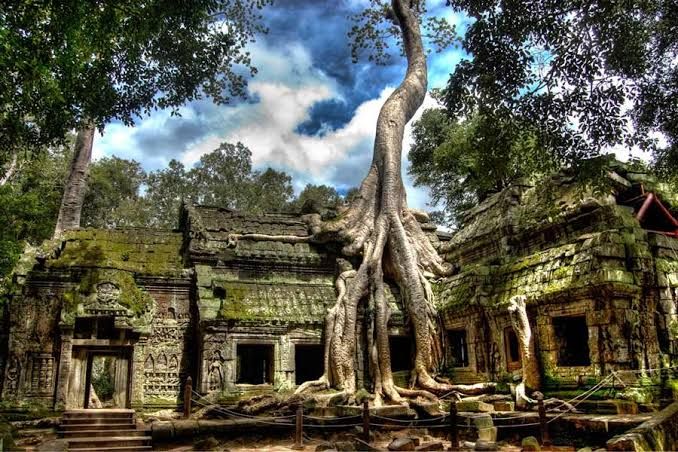
Ta Prohm, constructed in 1186 AD by King Jayavarman VII, began life as Rajavihara a Buddhist monastery, university and shrine honoring his mother, the goddess Prajnaparamita . Once home to more than 12,500 residents, including priests, dancers and artisans, the sprawling complex reflected both religious devotion and imperial ambition .
Abandoned in the 15th century, Ta Prohm was rediscovered by the École Française d’Extrême‑Orient in the early 20th century. Unlike Angkor Wat, it was deliberately left largely unrestored to preserve its dramatic fusion with the jungle . Massive silk‑cotton and strangler fig trees weave through corridors and hold entire towers in place, creating a hauntingly beautiful “lost temple” atmosphere credited for its appearance in the Tomb Raider film .
Recent conservation efforts by the Archaeological Survey of India and APSARA have focused on structural stabilization and walkway creation, enabling safe exploration while maintaining the ruinous charm . Rediscovered artifacts include a recently unearthed 12th-century Buddha torso, matching a head found in 1927 currently awaiting reconstruction approval .
Today, visitors find an otherworldly blend of architecture overtaken by root and stone, where bas reliefs, devata carvings, and collapsed cloisters coexist in shaded mystery . Ta Prohm remains a must‑visit for anyone seeking the story of nature reclaiming human creation, offering a sensory-rich, cinematic exploration of Khmer heritage.
1. Angkor Wat
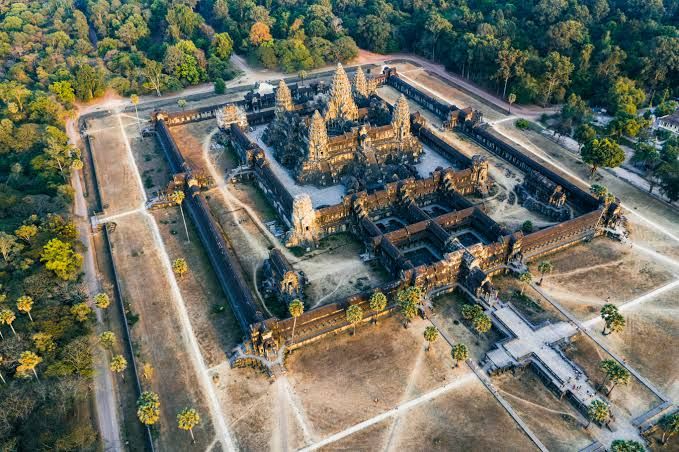
Angkor Wat stands as the world’s largest religious monument, built in the early 12th century by King Suryavarman II as a temple dedicated to Vishnu. This UNESCO World Heritage marvel is famous for its classical Khmer temple‑mount design, featuring five soaring central towers symbolizing Mount Meru, all surrounded by a vast reflective moat.
Its monumental galleries stretch nearly one kilometer, intricately carved with bas‑reliefs depicting the Ramayana, Mahabharata, celestial apsaras and daily life scenes offering scholars and visitors alike a visual epic that narrates ancient myth and Khmer expressiveness. Carvings almost 800 meters long showcase the empire’s artistry and storytelling prowess.
Beyond artistry, Angkor Wat served as both a political and spiritual statement central to state rituals, cosmic symbolism and royal identity. At sunrise, the temple’s reflection in the moat provides one of Southeast Asia’s most iconic images a powerful magnet for travelers and photographers worldwide.
Conservation efforts balance visitor demand with preservation: wooden boardwalks, guided paths and restricted zones protect vulnerable reliefs and prevent erosion. A mandatory Angkor pass provides access to Angkor Wat and neighboring temples.
To truly experience Angkor Wat, plan an early morning visit to witness the sunrise glow, followed by a measured walk through galleries to admire the temple’s hundreds of windows, towers and courtyards. It remains unrivaled as both an architectural wonder and sacred site a must‑visit landmark for ranking travel guides, cultural explorers and spiritual pilgrims.

